- Submissions

Full Text
Trends in Telemedicine & E-health
Epidemiological Study of COVID-19 Vaccination Coverage in Afghanistan, 2021
Samsor Rahat1* and Islam Saeed2
1National EPI Epidemiologist, Kabul, Afghanistan
2AFETP, Afghanistan National Public Health Institute (ANPHI), Afghanistan
*Corresponding author:Samsor Rahat, National EPI Epidemiologist, Kabul, Afghanistan
Submission: November 28, 2022; Published: May 12, 2023

ISSN: 2689-2707 Volume 4 Issue 2
Abstract
Background: In response to COVID-19 worldwide catastrophe, vaccination became the golden choice of
virus control. With the help of international donors, Afghanistan started the administration of COVID-19
vaccines for eleven at-risk categories back in February 2021. This study aims to provide basic descriptive
of vaccination epidemiological status as well as deployment of vaccine to at-risk categories in Afghanistan.
Methods: A descriptive study was conducted to analyze secondary data from the District Health
Information System-2 (DHIS2) at national level in Ministry of Public Health. That is a database developed
and launched after COVID-19 pandemic. The immunization status at provincial level and gender-based
data are analyzed in this study.
Results: A total of 4,855,683 doses of COVID-19 vaccine were administrated in 2021 of which 10% of
the total population were fully vaccinated and 11% has received at least one dose of vaccine. The highest
coverage of this vaccine is observed (28%) and (12%) for Kabul (central region) and Herat (west region)
provinces respectively. Totally 54% males and 46% females received the COVID-19 vaccines in 2021.
The highest coverage was reported in the elderly group (18-50 years) which were 2,608,4068 people. Of
all doses 925,656 (19%) were Covishield, 677,656 (14%) were Sinopharm and 3,252,851 (67%) were
Janssen & Janssen vaccines. Vaccine coverage differed among target/at risk categories.
Conclusion: Vaccine coverage for at least one at-risk category (older than 50 years) is lower than
expected with higher interest to one-dose regimen vaccine. The low coverage shows low demand for
vaccine uptake. Although the results are not inclusive, still the demand for interventions to improve public
awareness about COVID-19 is much needed. Furthermore, advocacy for full vaccination is required.
Keywords:Covid; Vaccine; Coverage; Immunization
Introduction
The Covid-19 pandemic is declared the worst public health crises in the world, with over 528 million global confirmed cases and 6,294,969 global deaths across 230 countries and territories as of June 03, 2022. Among 73 GAVI eligible countries, 72 of them have reported Covid-19 cases, Indonesia, India and Pakistan are those countries which comprising the highest number of cases [1]. There is no specific treatment for Covid-19, but different vaccines are introduced by different companies which are administrating worldwide for prevention and control of this disease. WHO recommends some measures in order to decrease the spread of virus transmission such as physical distance, avoid gathering, closure of school and Universities, wearing masks and home quarantine. In response to COVID-19 worldwide catastrophe, vaccination became the golden choice of virus control. Totally 12 billion vaccine doses have been administrated globally.
Afghanistan reported the first case of Covid-19 in 24th Feb 2020 in Herat province which was imported case and had travel history from Iran. Afghanistan reported 128,096 confirmed cases and 5,498 deaths as of June 03, 2022. During Covid-19 around 300,000 Afghans returned from Iran and Pakistan and this overwhelmed government’s attempts to control the outbreak [2]. With the help of international donors, Afghanistan received total 8,404,050 doses of COVID-19 vaccine of Janssen, Sinopharm and Covishield types from COVAX facilities and international donors. Afghanistan developed National Deployment and Vaccination Plan (NDVP) for 20% of total population and started the administration of COVID-19 vaccines for eleven at-risk categories back in February 2021. The eleven at risk categories are as follow: Health workers, teacher, security personnel, prisoners, people with co-morbidities, people over age of 50 years old, nomadic population, people living in DIP camps, returnees, government employees, people living in urban slums and people age between 18-50.
Objectives
The primary objective of the study is to provide basic descriptive of vaccination epidemiological status as well as deployment of vaccine to at-risk categories in Afghanistan.
The secondary objectives of the study are:
a) To analyze the COVID-19 vaccination coverage by gender,
risk categories, vaccine type and geographical locations.
b) To know the vaccine uptake rate during vaccination
campaign and normal days.
Methodology
A descriptive study to analyze secondary data from the District Health Information System-2 (DHIS2) at national level in Ministry of Public Health. That is a database developed and launched after COVID-19 pandemic. The immunization status at provincial level and gender-based data are analyzed in this study. We managed and analyzed the data using Ms. Excel 2016 and Epi info7.2.
Result
Based on UNDP data, the estimated population of Afghanistan in 2021 were 39,835,428. A total of 4,855,683 doses of COVID-19 vaccine were administrated in 2021 of which 10% of the total population were fully vaccinated and 11% has received at least one dose of vaccine and 1% of them were partly vaccinated (Figure 1). The highest total COVID-19 vaccinated coverage is observed 1,357,543 (28%) and 593,953 (12%) for Kabul (central region) and Herat (west region) provinces respectively (Figure 2). Totally 54% males and 46% females received the COVID-19 vaccines in 2021 (Figure 3). The highest coverage was reported in the elderly group (18-50 years) which were 2,608,4068 people. Vaccine coverage differed among target/at risk categories (Table 1). Of all doses 925,656 (19%) were Covishield, 677,656 (14%) were Sinopharm and 3,252,851 (67%) were Janssen & Janssen vaccines (Figure 4). In addition, the daily vaccination coverage analyzed and the following histogram has been developed from the data: In 2021, the Ministry of Public Health of Afghanistan conducted two rounds of COVID-19 campaigns in the months of August and October 2021 which shows the high uptake of COVID-19 vaccine in these months (Figure 5).
Table 1:
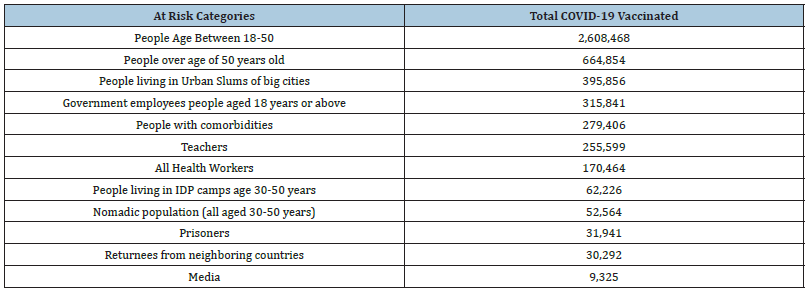
Figure 1:COVID-19 vaccination coverage (%) year 2021.
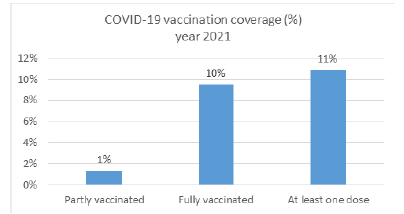
Figure 2:Total COVID-19 vaccinated by provincial level in 2021.
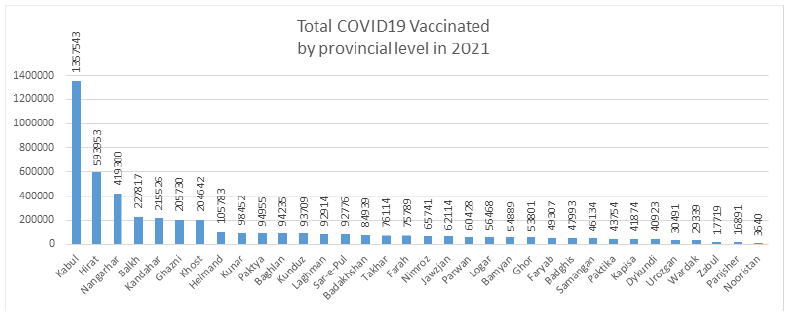
Figure 3:Total COVID-19 vaccinated.
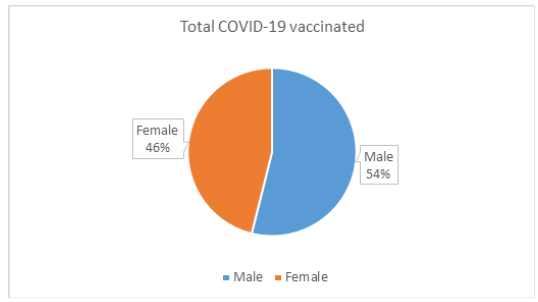
Figure 4:Total administrated doses 2021.

Figure 5:Afghanistan.
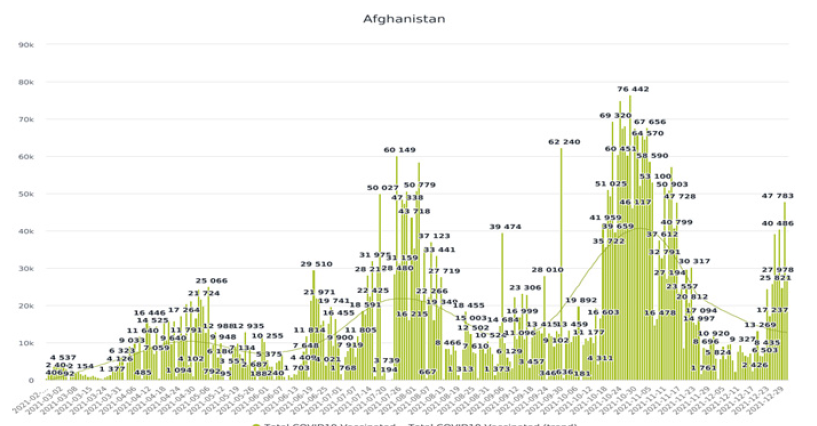
Discussion
This study indicates that the coverage of single dose regimen vaccine is 67% which higher than other type of vaccines in Afghanistan. In addition, the proportion of male to female regarding vaccination uptake is 54% which shows a slight inequity of gender. The higher coverages of vaccination were observed during the campaign days which indicates low demand of people in utilization in the fixed sites. Moreover, the coverage for “over 50 ages” at risk category is lower than expected.
Conclusion
Vaccine coverage for at least one at-risk category (older than 50 years) is lower than expected with higher interest to one-dose regimen vaccine. The low coverage shows low demand for vaccine uptake. Although the results are not inclusive, still the demand for interventions to improve public awareness about COVID-19 is much needed. Furthermore, advocacy for full vaccination is required.
References
© 2023 Samsor Rahat. This is an open access article distributed under the terms of the Creative Commons Attribution License , which permits unrestricted use, distribution, and build upon your work non-commercially.
 a Creative Commons Attribution 4.0 International License. Based on a work at www.crimsonpublishers.com.
Best viewed in
a Creative Commons Attribution 4.0 International License. Based on a work at www.crimsonpublishers.com.
Best viewed in 







.jpg)






























 Editorial Board Registrations
Editorial Board Registrations Submit your Article
Submit your Article Refer a Friend
Refer a Friend Advertise With Us
Advertise With Us
.jpg)






.jpg)














.bmp)
.jpg)
.png)
.jpg)










.jpg)






.png)

.png)



.png)






